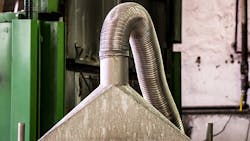The U.S. Department of Labor’s final rule on silica exposure is receiving a welcome reception from industry groups.
The rule, which limits exposure to an 8-hour time-weighted average of 50 micrograms of respirable crystalline silica per cubic meter of air, puts in place recommendations the National Institute for Occupational Safety and Health made in 1974.
Terry O’Sullivan, general president of the Laborers’ International Union of North America (LiUNA), called the new standard “a welcome and long overdue step towards safer job sites.”
“For too long, workers in the construction industry have been needlessly exposed to silica-related diseases. With implementation of this rule, millions of construction workers – including the hardworking men and women of LiUNA – will be safer on the job,” O’Sullivan said.
The American Public Health Association’s executive director, Georges Benjamin, similarly referred to the new rule as a “life-saving public health victory.”
While deaths from acute silicosis have declined since the 1930s when the dangers of silica first were realized, workers are still dying from the disease and as well as from other diseases like silicotuberculosis and lung cancer caused by silica exposure, according to APHA Occupational Health and Safety Section member Rosemary Sokas, who is chair of the department of human science at Georgetown University School of Nursing & Health Studies and testified during public hearings on the silica rule.
“The OSHA silica standard, if adequately enforced, should also be a force for reducing health disparities, since occupational silica exposure disproportionately impacts low income, African American and Latino workers,” Sokas said.
Javier Garcia Hernandez, a construction worker and former consultant for the Philadelphia Area Project on Occupational Safety and Health who testified in April 2014 at an OSHA hearing, likewise said the rule should help protect vulnerable workers.
“Controlling silica dust is especially important to immigrant workers and other vulnerable groups, who are often assigned the dirtiest, most dangerous jobs on any worksite,” Garcia Hernandez said.
James Boland, president of the International Union of Bricklayers and Allied Craftworkers (BAC), says his organization will help to protect the standard.
“Together, we can make workers’ lives better,” said Boland, who praised the Department of Labor’s cooperation with industry groups as well as with the Obama administration, particularly with President Obama, whom he called a “Collaborator-in-Chief.”
The next step, the National Council for Occupational Safety and Health (National COSH) says, will be to make sure employers know how to control silica dust.
“That means training and materials provided in language workers can understand. It also means informing workers about their right to a safe and healthy workplace – and the actions they can take to enforce their rights,” said Peter Dooley, a health and safety project consultant at national COSH.
About the Author
Ginger Christ
Associate Editor
Ginger Christ is an associate editor for EHS Today, a Penton publication.
She has covered business news for the past seven years, working at daily and weekly newspapers and magazines in Ohio, including the Dayton Business Journal and Crain’s Cleveland Business.
Most recently, she covered transportation and leadership for IndustryWeek, a sister publication to EHS Today.
She holds a bachelor of arts in English and in Film Studies from the University of Pittsburgh.
